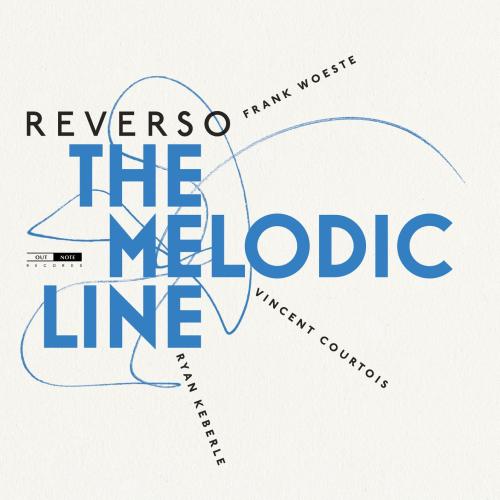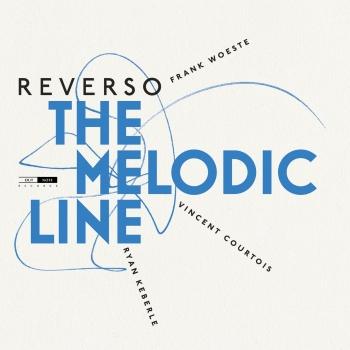
Reverso - The Melodic Line Frank Woeste, Ryan Keberle, Vincent Courtois
Album Info
Album Veröffentlichung:
2020
HRA-Veröffentlichung:
14.02.2020
Label: Outnote Records
Genre: Jazz
Subgenre: Contemporary Jazz
Interpret: Frank Woeste, Ryan Keberle, Vincent Courtois
Das Album enthält Albumcover Booklet (PDF)
- 1 Blue Feather 04:17
- 2 Exemplar 07:24
- 3 Up North 04:51
- 4 Montparnasse 04:18
- 5 Absinthe 05:53
- 6 Sisters of Mine 04:19
- 7 L'Arlequin lunaire 06:27
- 8 Major Jack 04:28
- 9 Clara 05:02
Info zu Reverso - The Melodic Line
Ryan Keberle & Frank Woeste Team Up Again For Second Reverso Album, This Time In Trio Format with French Cellist Vincent Courtois
“The Melodic Line” finds inspiration in the music of “Les Six,” an early 20th century collective of French composers.
Among the many reasons American trombonist Ryan Keberle and French pianist Frank Woeste started their co-led ensemble, Reverso, was that both saw their music as a two-way street. “We were interested not only in blending classical and jazz, but also in the historical significance of how jazz and classical have influenced each other over the last 120 years,” says Keberle. “And, still to this day, many musicians —Frank and I included — straddle both worlds.”
“I love the chamber music vibe that we have with this band,” adds Woeste. “Of course, this is jazz, because it’s very it’s improvised, but at the same time you can hear the classical background in it.”
That was certainly true of Suite Ravel, the group’s debut which took inspiration from the music of Maurice Ravel — particularly the piano suite “Le Tombeau de Couperin” — to create an album of classically informed jazz. With The Melodic Line, Reverso digs even deeper into the possibilities of classical/jazz cross-pollination by looking into the music of Les Six, a group of early 20th Century French composers whose members included Darius Milhaud, Francis Poulenc, Arthur Honneger, and Germaine Tailleferre.
Why Les Six? Part of the answer lies in the Reverso origin story, in which Keberle and Woeste, who met during a Dave Douglas recording session in 2015, received a grant from the French American Jazz Exchange. “One of the stipulations of the grant was that the theme of the project needed to somehow incorporate French and/or American culture,” explains Keberle. “Both Frank and I were deeply involved in classical piano growing up and Ravel just happened to be our mutual favorite composer.
When it came time to make a second album, the two tried to find a focus that would be similar, but different. “We knew we wanted to stay in that world,” says Keberle. “We threw a bunch of composers and musical inspirations around, and finally settled on Les Six. We liked the fact that, musically, many of their compositions contain this “jazzy” sonority and aesthetic.”
Milhaud, in particular, has considerable cachet in the jazz world, in part because his 1923 ballet “La création du monde” included a reasonable approximation of Chicago-style jazz, but also because one of his later students was pianist Dave Brubeck.
Woeste was particularly interested in a suite of piano pieces Milhaud wrote while attached to the French Legion in Brazil between 1917-19. Called “Saudades,” the music drew heavily on folkloric Brazilian elements for its melodies and rhythms. “It was great fun to have that harmonic language from French music and also some Brazilian influences,” says Woeste.
Keberle, on the other hand, was intrigued by the music of Tailleferre, the sole female member of Les Six. “I was blown away by her music. She was someone I’d never even heard of,” he says. “Talking to my friends in the classical world, a lot of them hadn’t heard of her either. She was the forgotten member.” But as Keberle explored her work, particularly “Impromptu” and “Pastorales” for solo piano, “Sonatine for Violin and Piano,” “Trio for Piano, Violin and Cello,” and the film score for Bretagne, he was amazed by how much she had accomplished over her seventy-year career. “There’s a very diverse collection of musical styles and genres that she wrote in, and many different instrumentations, everything from operas to piano trios.”
Being composers as well as improvisors, Keberle and Woeste used their insights gained through playing and studying these pieces to create works of their own. “Frank and I have a very similar approach to composition,” Keberle says. After immersing himself in the music of Les Six, playing it on both piano and trombone, he finds that those influences will naturally work their way into his artistic expression. “I’m trying to get into as pure and uninhibited of a creative musical space as possible,” he says. “I’m essentially improvising when I compose.”
Similarly, when Woeste is writing for Reverso, he tries to “extract the DNA of a piece — bits of melody, bits of harmonic structure — and create something new from that. I want there to be a direct connection, not just to play the piece and put a rhythm under it.
It helps that Reverso doesn’t employ a standard jazz rhythm section. Although Suite Ravel used drummer Jeff Ballard alongside cellist Vincent Courtois, The Melodic Line uses only Courtois. “He is by far the most successful and critically acclaimed improvising cellist in Paris, perhaps in France, maybe even in all of Europe,” says Keberle. “And the resonance between trombone and cello is so beautiful. One of my favorite things to do is simply write unison lines with the two instruments. It’s just such a beautiful sound, so warm.”
“Not having a rhythm section means you can stretch the time a little bit,” adds Woeste. “You can add a lot of dynamics — crescendo, decrescendo. You can almost be as vibrant as a piano trio — piano with the violin and cello, except it’s with trombone.”
Frank Woeste, piano
Ryan Keberle, trombone
Vincent Courtois, cello
Ryan Keberle
Hailed in the Downbeat International Critics Poll as #1 Rising Star trombonist, a player “of vision and composure” according to The New York Times, Ryan Keberle has developed a one-of-a-kind voice both on his instrument and as a bandleader, earning distinction among jazz’s most adventurous new voices.
Keberle’s outlets include the celebrated piano-less group Catharsis; the Big Band Living Legacy Project, carrying on the rich musical language of big band jazz (’30s through ’70s), featuring top veteran players in the idiom; and Reverso — Suite Ravel, a chamber-jazz collaboration with French pianist Frank Woeste featuring cellist Vincent Courtois and drummer Jeff Ballard.
Keberle's music integrates his wide-ranging experiences into a highly personal vernacular — immersed in jazz tradition, drawing on world music, pop and other influences, seeking fresh and original pathways. His earliest work as a leader, on Double Quartet and Heavy Dreaming, featured an ensemble thick with brass textures and a malleable little-big-band aesthetic. Catharsis, with its invigorating trombone-trumpet frontline, agile rhythm section and the voice and guitar of Camila Meza, debuted in 2012 with Music is Emotion, followed by Into the Zone in 2014 and Azul Infinito in 2016 (the latter two released on Dave Douglas’s Greenleaf label). Billboard picked Azul Infinito as one of “five jazz albums you need to hear.”
In 2017 Catharis turned its attention to political turmoil in the U.S. with the protest album Find the Common, Shine a Light, praised by The Nation as “unpretentiously intelligent and profoundly moving.” Find the Common also saw Keberle emerging as a solid performing keyboardist (his first instrument).
Catharsis has toured internationally for years, engaging audiences at the Toronto, Ottawa, Rochester and Bergamo International Jazz Festivals, and at premier jazz clubs including Pizza Express (London), Le Duc des Lombards (Paris), Stadtgarten (Cologne), Jazz Standard and Jazz at Lincoln Center (New York) and bluewhale (Los Angeles). The band was also featured in NPR’s prestigious Tiny Desk Concert series and on the French TV channel Mezzo.
Keberle has also worked in endlessly varied settings with musicians ranging from superstars to up-and-coming innovators, in jazz, indie rock, R&B and classical music. As a featured soloist with the Maria Schneider Orchestra, he collaborated with David Bowie on his 2015 single “Sue (Or in a Season of Crime).” He has performed extensively with the acclaimed songwriter Sufjan Stevens and with Darcy James Argue’s groundbreaking big band Secret Society. He has also played in the big bands of Pedro Giraudo and MacArthur Fellow Miguel Zenón, with Brazilian superstar Ivan Lins, and with the Saturday Night Live house band. He has accompanied soul hit-makers Alicia Keys and Justin Timberlake as well as jazz legends Rufus Reid and Wynton Marsalis.
Keberle recently received a New Jazz Works grant from Chamber Music America, funded by the Doris Duke Foundation. He has also been recognized with the Mid-Atlantic Arts Foundation’s French American Exchange and Tour Support grant and its Special Presenter Initiative, as well as the USArtists International Grant.
Born and raised in Spokane, Washington, Keberle was surrounded by music from an early age. His father was a jazz trumpeter and professor at Whitworth University, his mother a piano teacher and longtime church music director. Keberle studied classical violin and piano before adopting trombone as his primary instrument. He moved east in 1999 to study at the Manhattan School of Music, where he came under the tutelage of renowned trombonist Steve Turre, as well as composers Michael Abene and Manny Albam. He was the sole member of his graduating class to receive the William H. Borden Award for musical excellence in jazz. In May 2003 he was among Juilliard's first graduating Jazz Studies class, learning under trombonist Wycliffe Gordon and big-band leader/arranger David Berger, with whom he has worked ever since.
Project Reverso
Among the many reasons American trombonist Ryan Keberle and French pianist Frank Woeste started their co-led ensemble, Reverso, was that both saw their music as a two-way street. “We were interested not only in blending classical and jazz, but also in the historical significance of how jazz and classical have influenced each other over the last 120 years,” says Keberle. “And, still to this day, many musicians —Frank and I included — straddle both worlds.”
“I love the chamber music vibe that we have with this band,” adds Woeste. “Of course, this is jazz, because it’s very it’s improvised, but at the same time you can hear the classical background in it.”
That was certainly true of Suite Ravel, the group’s debut which took inspiration from the music of Maurice Ravel — particularly the piano suite “Le Tombeau de Couperin” — to create an album of classically informed jazz. With The Melodic Line, Reverso digs even deeper into the possibilities of classical/jazz cross-pollination by looking into the music of Les Six, a group of early 20th Century French composers whose members included Darius Milhaud, Francis Poulenc, Arthur Honneger, and Germaine Tailleferre.
Booklet für Reverso - The Melodic Line












